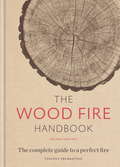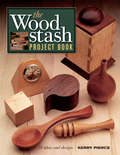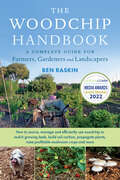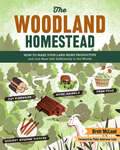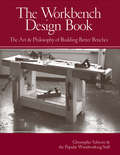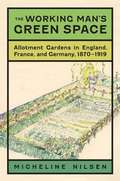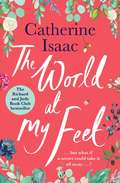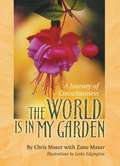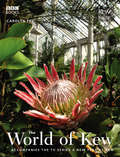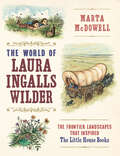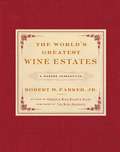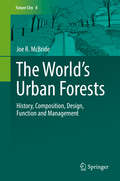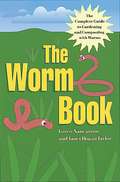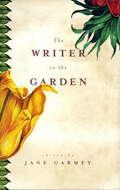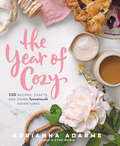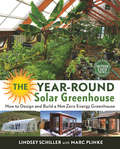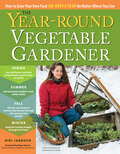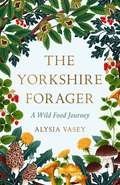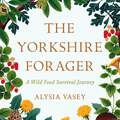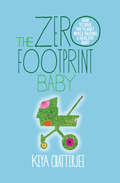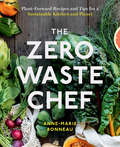- Table View
- List View
The Wood Fire Handbook: The complete guide to a perfect fire
by Vincent Thurkettle'Sound, well-seasoned advice [on] how to bring wood fires into our lives.' - BBC CountryfileThe Wood Fire Handbook shows you that the soothing effect of dancing flames and glowing embers is a simple pleasure to have in our lives. Understanding everything that underpins the perfect wood fire makes it even more enjoyable. Vincent Thurkettle's handbook is the essential companion and manual.The expert insight and knowledge in this book allow everyone to rediscover the skills of previous generations and savour the delight of a perfect wood fire in all its incarnations.Contents include...Understand which trees make the best firewoodLearn how to split, season, and store woodLay the perfect fireMake an ingenious campfireChoose wood for its scent...and much more!This revised edition features updated information on wood-burning stoves, 'clean' wood and other environmental considerations.
The Wood Fire Handbook: The complete guide to a perfect fire
by Vincent Thurkettle'Sound, well-seasoned advice [on] how to bring wood fires into our lives.' - BBC CountryfileThe Wood Fire Handbook shows you that the soothing effect of dancing flames and glowing embers is a simple pleasure to have in our lives. Understanding everything that underpins the perfect wood fire makes it even more enjoyable. Vincent Thurkettle's handbook is the essential companion and manual.The expert insight and knowledge in this book allow everyone to rediscover the skills of previous generations and savour the delight of a perfect wood fire in all its incarnations.Contents include...Understand which trees make the best firewoodLearn how to split, season, and store woodLay the perfect fireMake an ingenious campfireChoose wood for its scent...and much more!This revised edition features updated information on wood-burning stoves, 'clean' wood and other environmental considerations.
The Wood Stash Project Book
by Kerry PierceGet more out of every piece of wood!Every woodworker has a pile of wood scraps, rips and cutoffs. The Wood Stash Project Book shows you how to put this perfectly good material to use in fun and creative ways.You'll learn how to turn "leftovers" into great gifts using carving, turning and your favorite hand-tooling techniques. Step-by-step photos are included for each project, ranging from kitchen utensils and small sculptures to jewelry, letter openers, boxes and more.Learn how to turn your wood scrap into fun, finished pieces like these:Cherry-Wood VaseFaceted Wooden BeadsCherry Key CacheBandsawn Maple Change BoxCherry SpoonMixed-Wood Cutting BoardBasket for Cut FlowersThree-Tier Keepsake ChestSet of CheckersDesk ClockPorthole Picture FramesCherry ShelvesWalnut BoxFigured Maple BoxFigured Maple Spatula
The Woodchip Handbook: A Complete Guide for Farmers, Gardeners and Landscapers
by Ben RaskinThe first and only complete guide to sourcing and using woodchip—an abundant, inexpensive, and ecologically sustainable material—for savvy growers and landscapers at any scale, from farm to garden to greenhouse. The Woodchip Handbook is the essential guide to the many uses of woodchip both in regenerative agriculture and horticulture. Author Ben Raskin, Head of Horticulture and Agroforestry at the Soil Association, draws on his extensive practical experience using woodchip, provides the latest research from around the world, and presents inspiring case studies from innovative farmers. The book explores and unlocks the tremendous potential of woodchip to enhance soil health and plant growth: As a natural mulch for weed suppression, temperature buffering, and water conservation As a growing medium for propagating plants As a decomposing source of warmth for hotbeds in the greenhouse or hoop house As a carbon-rich compost ingredient that supports beneficial fungi and microorganisms As a powerful soil health booster, when applied as small-sized ramial chipped wood As an ideal substrate for growing many kinds of edible or medicinal mushrooms As a sustainable, versatile, and durable material for foot paths and ornamental landscaping Some of these techniques, like mulching—or the renewable harvest potential from coppicing and pollarding trees—have been around forever. Yet there is always new science to be discovered, such as the role that salicylic acid from willow woodchip can play in preventing tree diseases or promoting livestock health when used as a bedding material. Whether you are a commercial grower or farmer, a permaculture practitioner, or a serious home gardener producing your own fruit and vegetables, The Woodchip Handbook will show you how to get the most out of this readily available and renewable material.
The Woodchip Handbook: A Complete Guide for Farmers, Gardeners and Landscapers
by Ben RaskinThe first and only complete guide to sourcing and using woodchip—an abundant, inexpensive, and ecologically sustainable material—for savvy growers and landscapers at any scale, from farm to garden to greenhouse.The Woodchip Handbook is the essential guide to the many uses of woodchip both in regenerative agriculture and horticulture. Author Ben Raskin, Head of Horticulture and Agroforestry at the Soil Association, draws on his extensive practical experience using woodchip, provides the latest research from around the world, and presents inspiring case studies from innovative farmers.The book explores and unlocks the tremendous potential of woodchip to enhance soil health and plant growth:• As a natural mulch for weed suppression, temperature buffering, and water conservation• As a growing medium for propagating plants• As a decomposing source of warmth for hotbeds in the greenhouse or hoop house• As a carbon-rich compost ingredient that supports beneficial fungi and microorganisms• As a powerful soil health booster, when applied as small-sized ramial chipped wood• As an ideal substrate for growing many kinds of edible or medicinal mushrooms• As a sustainable, versatile, and durable material for foot paths and ornamental landscapingSome of these techniques, like mulching—or the renewable harvest potential from coppicing and pollarding trees—have been around forever. Yet there is always new science to be discovered, such as the role that salicylic acid from willow woodchip can play in preventing tree diseases or promoting livestock health when used as a bedding material.Whether you are a commercial grower or farmer, a permaculture practitioner, or a serious home gardener producing your own fruit and vegetables, The Woodchip Handbook will show you how to get the most out of this readily available and renewable material.2022 GardenComm Media Awards Gold Medal of Achievement
The Woodland Homestead: How to Make Your Land More Productive and Live More Self-Sufficiently in the Woods
by Philip Ackerman-Leist Brett McLeodPut your wooded land to work! This comprehensive manual shows you how to use your woodlands to produce everything from wine and mushrooms to firewood and livestock feed. You’ll learn how to take stock of your woods; use axes, bow saws, chainsaws, and other key tools; create pasture and silvopasture for livestock; prune and coppice trees to make fuel, fodder, and furniture; build living fencing and shelters for animals; grow fruit trees and berries in a woodland orchard; make syrup from birch, walnut, or boxelder trees; and much more. Whether your property is entirely or only partly wooded, this is the guide you need to make the best use of it.
The Workbench Design Book: The Art & Philosophy of Building Better Benches
by Christopher SchwarzThe follow-up book to Workbenches: From Design & Theory to Construction & UseComplete plans, expert instruction and rationale for building nine workbench formsInstruction on improving existing workbenches for better workholding and an improved woodworking shop.The Workbench Design Book not only shows how to design a workbench--it also discusses and presents nine specific designs plus critiques of 10 additional workbenches, with suggestions for making any bench work most effectively for the kind of work the user does. The 9 workbench plans have a range suitable for all workshop needs, from handwork to power tools. A discussion of workbench design rules teach what's effective and why in a multitude of workshop situations. Additional workholding options--from shop-made jigs and commercial bench dogs to vise hardware--are also provided.
The Working Man's Green Space
by Micheline NilsenWith antecedents dating back to the Middle Ages, the community garden is more popular than ever as a means of procuring the freshest food possible and instilling community cohesion. But as Micheline Nilsen shows, the small-garden movement, which gained impetus in the nineteenth century as rural workers crowded into industrial cities, was for a long time primarily a repository of ideas concerning social reform, hygienic improvement, and class mobility. Complementing efforts by worker cooperatives, unions, and social legislation, the provision of small garden plots offered some relief from bleak urban living conditions. Urban planners often thought of such gardens as a way to insert "lungs" into a city.Standing at the intersection of a number of disciplines--including landscape studies, horticulture, and urban history-- The Working Man's Green Space focuses on the development of allotment gardens in European countries in the nearly half-century between the Franco-Prussian War and World War I, when the French Third Republic, the German Empire, and the late Victorian era in England saw the development of unprecedented measures to improve the lot of the "laboring classes." Nilsen shows how community gardening is inscribed within a social contract that differs from country to country, but how there is also an underlying aesthetic and social significance to these gardens that transcends national borders.
The World at My Feet
by Catherine IsaacThe dazzling new novel from Richard & Judy book club author Catherine Isaac, The World at my Feet is a story about the transforming power of love, as one woman journeys to uncover the past and reshape her future.The secrets that bind us can also tear us apart… 1990. Harriet is a journalist. Her job takes her to dangerous places, where she asks questions and tries to make a difference. But when she is sent to Romania, to the state orphanages the world is only just learning about, she is forced to rethink her most important rule. 2018. Ellie is a gardener. Her garden is her sanctuary, her pride and joy. But, though she spends long days outdoors, she hasn&’t set foot beyond her gate for far too long. Now someone enters her life who could finally be the reason she needs to overcome her fears. From post-revolution Romania to the idyllic English countryside, The World at My Feet is the story of two women, two worlds, and a journey of self-discovery that spans a lifetime.** Shhh... Can you keep a secret? We can&’t wait to hear what you think about #TheWorldAtMyFeet. No spoilers please! ** 'The World at My Feet brought me to tears. What a beautifully written and incredibly moving novel' Beth O'Leary, author of The Flatshare 'Such an interesting and beautifully written book – I loved it and would highly recommend adding it to your 2021 reading list. It is a wonderful story that I know readers are going to feel moved and uplifted by' Libby Page, author of The Lido &‘A poignant and perceptive novel of love and courage in the face of terrible adversity&’ Erica James, author of Letters From the Past &‘What a moving and uplifting story this is – Catherine Isaac writes with real humanity and kindness, which is exactly what we all need right now&’ Lucy Diamond, author of An Almost Perfect Holiday &‘The World at my Feet is a profoundly moving, heart-filled story showing that, even in the darkest winter, new shoots of love, laughter and hope are waiting to burst through… Catherine Isaac handles Ellie&’s backstory with the kind of sensitivity and delicacy that&’s the mark of an exceptionally accomplished writer. The World at my Feet is exactly the kind of story we all need right now. I adored it&’ Sarah Haywood, author of The Cactus 'Beautifully written, thought-provoking and ultimately uplifting – The World At My Feet is Catherine Isaac's best book so far!' Debbie Johnson, author of Maybe One Day
The World is in My Garden
by Chris Maser Zane MaserThe World is in my Garden: A Journey of Consciousness is based on a simple premise: the private garden is a metaphor for everything that goes on in the macrocosm, including ecological, social, personal and spiritual issues. The authors work the metaphor of the garden in a rich way. This book show us how to connect what seems like a simple personal act, tending a home garden to larger social issues. They guide us through four garden gates: Ecological Consciousness, Social Consciousness, Personal Consciousness, and Spiritual Consciousness.Written with passion, warmth and a deep understanding of the worlds of matter and consciousness, the book teaches us how to live in a balanced way with all of life.
The World is in My Garden
by Chris Maser Zane MaserThe World is in my Garden: A Journey of Consciousness is based on a simple premise: the private garden is a metaphor for everything that goes on in the macrocosm, including ecological, social, personal and spiritual issues. The authors work the metaphor of the garden in a rich way. This book show us how to connect what seems like a simple personal act, tending a home garden to larger social issues. They guide us through four garden gates: Ecological Consciousness, Social Consciousness, Personal Consciousness, and Spiritual Consciousness.Written with passion, warmth and a deep understanding of the worlds of matter and consciousness, the book teaches us how to live in a balanced way with all of life.
The World is in My Garden
by Chris Maser Zane MaserThe World is in my Garden: A Journey of Consciousness is based on a simple premise: the private garden is a metaphor for everything that goes on in the macrocosm, including ecological, social, personal and spiritual issues. The authors work the metaphor of the garden in a rich way. This book show us how to connect what seems like a simple personal act, tending a home garden to larger social issues. They guide us through four garden gates: Ecological Consciousness, Social Consciousness, Personal Consciousness, and Spiritual Consciousness.Written with passion, warmth and a deep understanding of the worlds of matter and consciousness, the book teaches us how to live in a balanced way with all of life.
The World of Kew
by Carolyn FryWithout plants, there would be no life on earth. Kew Gardens is famous for its breathtaking displays of flowers and tree,s but this World Heritage Site is also a globally important scientific and historical organization. Scientists and gardeners use the plants and knowledge that have been collected at Kew since the eighteenth century to advance understanding of the earth's environment and of how plant lfe can be used for human benefit. Published to accompany the ten-part BBC2 series A New Year at Kew, this fascinating book takes us behind the scenes to show the extraordinary range of work carried out at Kew Gardens and Wakehurst Place - home to the Millenium Seed Bank - and by Kew staff overseas. From using forensic botant to micropagating plants facing extinction, from investigating herbal cures from Alzheimer's disease to replanting the volcano-ravaged island of Montserrat, the book shows us aspects of Kew's work that are largely hidden from view abut the benefits of which are far reachingl In the process it provides an absorbing and accessible introduction to such topical subjects as biodiversity, practical conservation and economic botany. Lavishly illustrated and filled with engrossing stories and engaging characters, this book brings to life the world of Kew and the global importance of its work.
The World of Laura Ingalls Wilder: The Frontier Landscapes that Inspired the Little House Books
by Marta McDowell“For gardeners, botanists, and fans of Laura Ingalls Wilder, this book looks at the beloved Little House on the Prairie author’s relationship to nature.” —Publishers Weekly The universal appeal of Laura Ingalls Wilder’s books springs from a life lived in partnership with the land, on farms she and her family settled across the Northeast and Midwest. In this revealing exploration of Wilder’s deep connection with the natural world, Marta McDowell follows the wagon trail of the beloved Little House series. You’ll learn details about Wilder’s life and inspirations, pinpoint the Ingalls and Wilder homestead claims on authentic archival maps, and learn to grow the plants and vegetables featured in the series. Excerpts from Wilder’s books, letters, and diaries bring to light her profound appreciation for the landscapes at the heart of her world. Featuring the beloved illustrations by Helen Sewell and Garth Williams, plus hundreds of historic and contemporary photographs, The World of Laura Ingalls Wilder is a treasure for anyone enchanted by Laura’s wild and beautiful life.
The World's Greatest Wine Estates: A Modern Perspective
by Robert M. Parker Jr.Robert Parker presents his first illustrated book, a beautifully designed guide to the greatest wine estates of the world.
The World’s Urban Forests
by Joe R. McBrideThe purpose of this book is to examine urban forests in cities around the world. It will ask questions about the history, composition, structure, and management of trees in urban areas. Data for this book was collected in 33 cities across broad geographical areas known as biomes. Constraints and opportunities imposed on urban forest composition, design, and management by the ecological characteristics of these biomes will be examined. The book will also address the cultural and historical factors that influenced the characteristics of urban forests around the world.
The Worm Book: The Complete Guide to Gardening and Composting with Worms
by Loren Nancarrow Janet Hogan TaylorWorms are the latest (as well as, of course, perhaps the oldest!) trend in earth-friendly gardening, and in this handy guide, the authors of DEAD SNAILS LEAVE NO TRAILS demystify the world of worm wrangling, with everything you need to know to build your own worm bin, make your garden worm-friendly, pamper your soil, and much much more.From the Trade Paperback edition.
The Writer in the Garden
by Jane GarmeyShow me a person without any prejudice of any kind on any subject and I'll show you someone who may be admirably virtuous but is surely no gardener.--Allen Lacy. Idiosyncratic, determined, and occasionally obsessed, gardeners have a lot to say about their outdoor passion. THE WRITER IN THE GARDEN brings together a host of writing gardeners and gardening writers reveling in their quirks, confessing their shortcomings, and sharing their experiences. Combing through a hundred years of garden writing, editor Jane Garmey has discovered some great contemporary works and rediscovered many classics: "I am strongly of the opinion," declares Gertrude Jekyll, "that the possession of a quantity of plants, however good the plants may be themselves and however ample their number, does not make a garden." "It isn't that I don't like sweet disorder, but it has to be judiciously arranged," writes Vita Sackville-West. "Gardeners are--let's face it--control freaks," Abby Adams admits. "Who else would willingly spend his leisure hours wrestling weeds out of the ground, blithely making life or death decisions about living beings, moving earth from here to there, changing the course of waterways?" Drawing on the work of more than fifty writers, THE WRITER IN THE GARDEN covers subjects ranging from the beauty of the garden to ornery weeds, the hazards of rare plant collecting, and the tribulations of inclement weather. The collection includes a range of authors from both sides of the Atlantic: from Edith Wharton, who insists that we could all learn a thing or two about design from the Italians, to Stephen Lacey, who reveals that his most exciting gardening moments are spent in the bath. Some of the other writers in the collection are: E. B. White, Beverly Nichols, Ken Druse, Eleanor Perenyi, W. S. Merwin, Mirabel Osler, Henry Mitchell, Jamaica Kincaid, Robert Dash, Sara B. Stein, Michael Pollan, M.F.K. Fisher, Anne Raver, Patti Hagan, Paula Deitz.
The Year of Cozy: 125 Recipes, Crafts, and Other Homemade Adventures
by Adrianna AdarmeFrom the author of the popular blog, A Cozy Kitchen, comes a beautifully photographed one-stop-shop book with all the recipes and projects you’ll need for some cozy inspiration this holiday season—and all year long. You’ll love Adrianna Adarme’s easy-to-follow instructions and will enjoy getting lost in her warm and comforting photographs. Organized by the months of the year and by categories as “Live,” “Do,” and “Make, ” this book offers ideas for activities, recipes, and DIY projects that make the little moments in life just as exciting as the big. Adarme gives us special (but totally doable) things we can do for others and ourselves. From quick recipes to easy crafts, she focuses on simple, inexpensive undertakings that have a big reward: happiness. The Year of Cozy will surely inspire you to march into your kitchen and craft closet to make something you can truly be proud of.
The Year-Round Solar Greenhouse: How to Design and Build a Net-Zero Energy Greenhouse
by Lindsey Schiller Marc PlinkeComprehensive coverage of passive solar greenhouse design including material selection, building methods and how to store thermal energy using a variety of simple and innovative strategies. Over a dozen case studies provide real-life inspiration, capped off with how-to guidance for building a durable, energy-efficient greenhouse. Variations include underground and aquaponic greenhouses and integrating solar panels to grow off-grid, year-round.
The Year-Round Vegetable Gardener: How to Grow Your Own Food 365 Days a Year, No Matter Where You Live
by Niki Jabbour Joseph De ScioseEven in winter’s coldest months you can harvest fresh, delicious produce. Drawing on insights gained from years of growing vegetables in Nova Scotia, Niki Jabbour shares her simple techniques for gardening throughout the year. Learn how to select the best varieties for each season, the art of succession planting, and how to build inexpensive structures to protect your crops from the elements. No matter where you live, you’ll soon enjoy a thriving vegetable garden year-round.
The Yorkshire Forager: A Wild Food Survival Journey
by Alysia VaseyAlysia Vasey's earliest memories are of walking alongside her grandfather as they explored the West Yorkshire moors that they called home. As an adult, this love for wild things stayed with her, even as she learnt that her family's knowledge of edible plants were a legacy of a much darker time during the Second World War. After leaving Yorkshire in search of adventure, Alysia was eventually guided home by her motto: Be true to yourself and you will become the person you were meant to be. She left her traditional path and took a far wilder journey that gradually evolved into one of the UK's most successful foraging businesses, supplying some of the greatest chefs in the world and the best restaurants in the country Her achievements are the result of a bit of luck, a lot of knowledge and a huge amount of self-belief. Here, Alysia also shares not only her story, but also her vast knowledge of UK plant lore. A true Yorkshirewoman, Alysia tells it like it is, and The Yorkshire Forager is full of tales of her family's adventures and misadventures in their search for top quality ingredients - you never know who you might meet in the woods - making this book as entertaining as it is informative.
The Yorkshire Forager: A Wild Food Survival Journey
by Alysia VaseyAlysia Vasey's earliest memories are of walking alongside her grandfather as they explored the West Yorkshire moors that they called home. As an adult, this love for wild things stayed with her, even as she learnt that her family's knowledge of edible plants were a legacy of a much darker time during the Second World War.After leaving Yorkshire in search of adventure, Alysia was eventually guided home by her motto: Be true to yourself and you will become the person you were meant to be. She left her traditional path and took a far wilder journey that gradually evolved into one of the UK's most successful foraging businesses, supplying some of the greatest chefs in the world and the best restaurants in the country Her achievements are the result of a bit of luck, a lot of knowledge and a huge amount of self-belief.Here, Alysia also shares not only her story, but also her vast knowledge of UK plant lore. A true Yorkshirewoman, Alysia tells it like it is, and The Yorkshire Forager is full of tales of her family's adventures and misadventures in their search for top quality ingredients - you never know who you might meet in the woods - making this book as entertaining as it is informative.(P)2020 Headline Pubkishing Group Ltd
The Zero Footprint Baby
by Keya ChatterjeeIn our culture, pregnancy, birth, and childrearing are deeply connected to consumption and resource use. From the baby shower to the minivan and the larger apartment or first house, the baby-raising years are the most hyper-consumptive of our lives, and can set a family on an unsustainable track for years to come. The Zero Footprint Baby: How to Save the Planet While Raising a Healthy Baby shows how to raise a child with little to no carbon footprint. The book covers every issue new parents face, including pregnancy (what kind of birth has the lowest impact); what to feed your baby (breastfeed, formula, or both?), childcare (who should take care of the baby, and how?), and of course, diapering. Using a mix of personal anecdotes, summarized research, and clear guidance on how to pursue the most sustainable baby-rearing options, The Zero Footprint Baby is the resource and reference book for all new parents with green inclinations. Keya Chatterjee is the director for international climate policy at the World Wildlife Fund. She previously served as a climate change specialist at the US Agency for International Development, and also worked on communicating climate issues while at NASA. Keya's commentary on climate change policy and sustainability issues has been quoted in numerous media outlets, including USA Today, The New York Times, Fox News, The Associated Press, The Washington Post, and NBC Nightly News. She was also featured in a special issue of Politico on climate change highlighting the "muscle of the movement."
The Zero-Waste Chef: Plant-Forward Recipes and Tips for a Sustainable Kitchen and Planet
by Anne-Marie BonneauA sustainable lifestyle starts in the kitchen with these use-what-you-have, spend-less-money recipes and tips, from the friendly voice behind @ZeroWasteChef.In her decade of living with as little plastic, food waste, and stuff as possible, Anne-Marie Bonneau, who blogs under the moniker Zero-Waste Chef, has preached that "zero-waste" is above all an intention, not a hard-and-fast rule. Because, sure, one person eliminating all their waste is great, but thousands of people doing 20 percent better will have a much bigger impact. And you likely already have all the tools you need to begin. In her debut book, Bonneau gives readers the facts to motivate them to do better, the simple (and usually free) fixes to ease them into wasting less, and finally, the recipes and strategies to turn them into self-reliant, money-saving cooks and makers. Rescue a hunk of bread from being sent to the landfill by making Mexican Hot Chocolate Bread Pudding, or revive some sad greens to make a pesto. Save 10 dollars (and the plastic tub) at the supermarket with Yes Whey, You Can Make Ricotta Cheese, then use the cheese in a galette and the leftover whey to make sourdough tortillas. With 75 vegan and vegetarian recipes for cooking with scraps, creating fermented staples, and using up all your groceries before they go bad--including end-of-recipe notes on what to do with your ingredients next--Bonneau lays out an attainable vision for a zero-waste kitchen.
